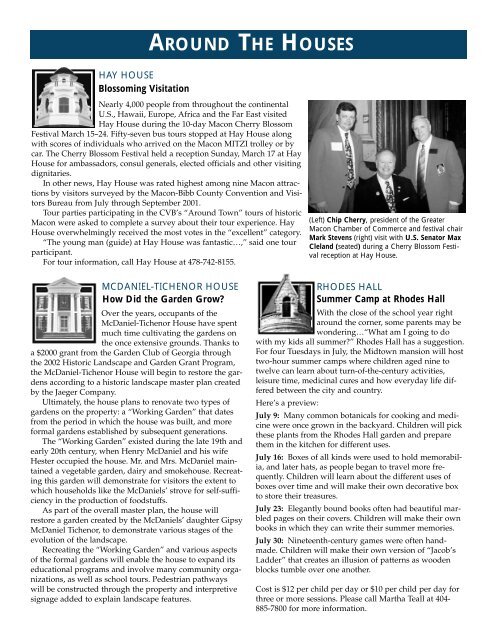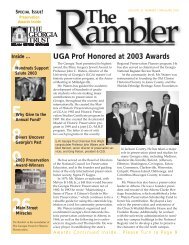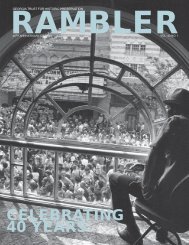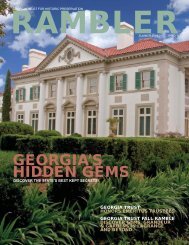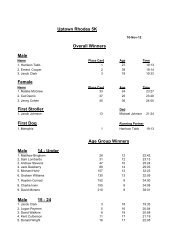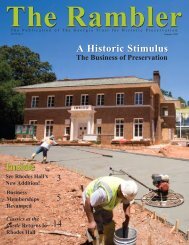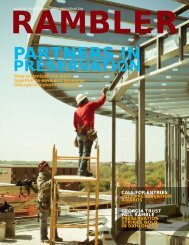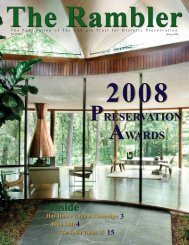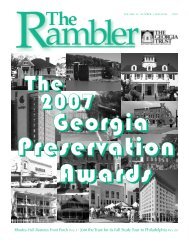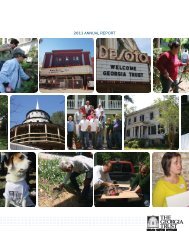May/June 2002 - The Georgia Trust for Historic Preservation
May/June 2002 - The Georgia Trust for Historic Preservation
May/June 2002 - The Georgia Trust for Historic Preservation
Create successful ePaper yourself
Turn your PDF publications into a flip-book with our unique Google optimized e-Paper software.
AROUND THE HOUSESHAY HOUSEBlossoming VisitationNearly 4,000 people from throughout the continentalU.S., Hawaii, Europe, Africa and the Far East visitedHay House during the 10-day Macon Cherry BlossomFestival March 15–24. Fifty-seven bus tours stopped at Hay House alongwith scores of individuals who arrived on the Macon MITZI trolley or bycar. <strong>The</strong> Cherry Blossom Festival held a reception Sunday, March 17 at HayHouse <strong>for</strong> ambassadors, consul generals, elected officials and other visitingdignitaries.In other news, Hay House was rated highest among nine Macon attractionsby visitors surveyed by the Macon-Bibb County Convention and VisitorsBureau from July through September 2001.Tour parties participating in the CVB’s “Around Town” tours of historicMacon were asked to complete a survey about their tour experience. HayHouse overwhelmingly received the most votes in the “excellent” category.“<strong>The</strong> young man (guide) at Hay House was fantastic…,” said one tourparticipant.For tour in<strong>for</strong>mation, call Hay House at 478-742-8155.(Left) Chip Cherry, president of the GreaterMacon Chamber of Commerce and festival chairMark Stevens (right) visit with U.S. Senator MaxCleland (seated) during a Cherry Blossom Festivalreception at Hay House.MCDANIEL-TICHENOR HOUSEHow Did the Garden Grow?Over the years, occupants of theMcDaniel-Tichenor House have spentmuch time cultivating the gardens onthe once extensive grounds. Thanks toa $2000 grant from the Garden Club of <strong>Georgia</strong> throughthe <strong>2002</strong> <strong>Historic</strong> Landscape and Garden Grant Program,the McDaniel-Tichenor House will begin to restore the gardensaccording to a historic landscape master plan createdby the Jaeger Company.Ultimately, the house plans to renovate two types ofgardens on the property: a “Working Garden” that datesfrom the period in which the house was built, and more<strong>for</strong>mal gardens established by subsequent generations.<strong>The</strong> “Working Garden” existed during the late 19th andearly 20th century, when Henry McDaniel and his wifeHester occupied the house. Mr. and Mrs. McDaniel maintaineda vegetable garden, dairy and smokehouse. Recreatingthis garden will demonstrate <strong>for</strong> visitors the extent towhich households like the McDaniels’ strove <strong>for</strong> self-sufficiencyin the production of foodstuffs.As part of the overall master plan, the house willrestore a garden created by the McDaniels’ daughter GipsyMcDaniel Tichenor, to demonstrate various stages of theevolution of the landscape.Recreating the “Working Garden” and various aspectsof the <strong>for</strong>mal gardens will enable the house to expand itseducational programs and involve many community organizations,as well as school tours. Pedestrian pathwayswill be constructed through the property and interpretivesignage added to explain landscape features.RHODES HALLSummer Camp at Rhodes HallWith the close of the school year rightaround the corner, some parents may bewondering…“What am I going to dowith my kids all summer?” Rhodes Hall has a suggestion.For four Tuesdays in July, the Midtown mansion will hosttwo-hour summer camps where children aged nine totwelve can learn about turn-of-the-century activities,leisure time, medicinal cures and how everyday life differedbetween the city and country.Here’s a preview:July 9: Many common botanicals <strong>for</strong> cooking and medicinewere once grown in the backyard. Children will pickthese plants from the Rhodes Hall garden and preparethem in the kitchen <strong>for</strong> different uses.July 16: Boxes of all kinds were used to hold memorabilia,and later hats, as people began to travel more frequently.Children will learn about the different uses ofboxes over time and will make their own decorative boxto store their treasures.July 23: Elegantly bound books often had beautiful marbledpages on their covers. Children will make their ownbooks in which they can write their summer memories.July 30: Nineteenth-century games were often handmade.Children will make their own version of “Jacob’sLadder” that creates an illusion of patterns as woodenblocks tumble over one another.Cost is $12 per child per day or $10 per child per day <strong>for</strong>three or more sessions. Please call Martha Teall at 404-885-7800 <strong>for</strong> more in<strong>for</strong>mation.


